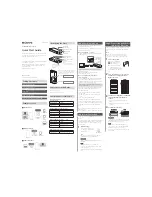
105
D14049.05
February 2009
Grey Headline
(continued)
TANDBERG
VIDEO COMMUNICATIONS SERVER
ADMINISTRATOR GUIDE
Introduction
Getting started
Overview and
status
System
configuration
VCS
configuration
Zones and
neighbors
Call
processing
Bandwidth
control
Firewall
traversal
Appendices
Applications
Maintenance
Call Policy
Enabling Call Policy
Call Policy is enabled and disabled using the
Call Policy mode
option on the
Call Policy configuration
page.
To go to the
Call Policy configuration
page:
VCS configuration > Call Policy > Configuration
•
To enable Call Policy using the CLI:
xConfiguration Policy AdministratorPolicy Mod
•
e
Call Policy mode
options are:
On
: Call Policy is enabled. If a CPL script has been uploaded,
this policy will be used. Otherwise, the policy configured using
the
Call Policy rules
page (
VCS configuration > Call Policy >
Rules
) will be used.
Off
: Call Policy is not in use.
!
You must click
Save
for any changes to the
Call Policy
Mode
to take effect.
Once you have enabled the use of Call Policy, you must
define the policy to be used. This is done either
using
the web interface
or by
uploading a CPL script
.
If Call Policy is on but a policy has not been configured,
then a default policy will be applied that allows all calls,
regardless of source or destination.
Configuring basic Call Policy using the web interface
The
Call Policy rules
page lists the web-configured call policy
rules currently in place, and allows you to create, edit and delete
simple Call Policy rules without having to write and upload a CPL
script.
To go to the
Call Policy rules
page:
VCS configuration > Call Policy > Rules
•
!
You will not be able to use the
Call Policy rules
page to
configure Call Policy if a CPL file is already in place. If
this is the case, on the
Call Policy configuration
page
(
VCS configuration > Call Policy > Configuration
) you will have the
option to
Delete uploaded file
. Doing so will delete the existing
Call Policy that was put in place using a CPL script, and enable
use of the
Call Policy rules
page for Call Policy configuration.
To add a new Call Policy rule, click
New
. You will be taken to the
Add Call Policy rule
page.
To edit an existing rule, click
View/Edit
. You will be taken to the
Edit Call Policy rule
page.
For all the above pages, the following fields apply:
Source pattern
The alias that the calling endpoint used to identify itself when
placing the call.
If this field is blank, the policy rule will to apply to all incoming
calls from unauthenticated users, i.e. calls where the endpoint
making the call is
not
either:
locally registered and authenticated with the VCS, or
•
registered and authenticated to a neighbor which in turn has
•
authenticated with the local VCS.
See the section
Call Policy and authentication
for more
information about unauthenticated users and Call Policy.
This field supports
regular expressions
.
Destination pattern
The alias that the endpoint dialed to make the call.
This field supports
regular expressions
.
Action
Whether or not a call that matches the source and destination
will be permitted.
Allow
: if both the
Source
and
Destination
aliases match those
listed, call processing will continue.
Reject
: if both the
Source
and
Destination
aliases match those
listed, the call will be rejected.
Rearrange
Each combination of
Source
and
Destination
is compared, in the
order shown on the
Call Policy rules
page, with the details of the
call being made until a match is found, at which point the call
policy will be applied.
To move a particular item to higher or lower in the list, thus giving
the rule a higher or lower priority, click on the
and
icons
respectively.
















































